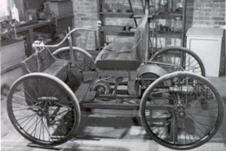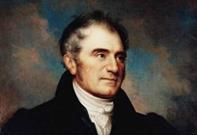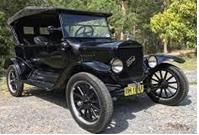A concise history of Automotive Paint
Paint jobs are the first thing most people notice about automobiles. Lackluster, faded paint will make any car look old and outdated, no matter how good its condition is. Cars with bright colors and high-gloss clear coats draw the eye, making the vehicles more appealing. Paint, and in particular, automotive paint, has a long and detailed history. As car manufacturers constantly strive to produce better, shinier, more durable paint coatings, car care product manufacturers invest time and effort in products that help enthusiasts keep the paintwork looking pristine. Instead, its history provides a fascinating insight into the technology behind the development of modern automotive painting processes.
38000 Years BC
The first samples of paint were produced by cavemen using hematite, manganese oxide and charcoal. Red or yellow ochre was used to give the paint colour and it was then used to produce cave drawings, some of which still exist today.

Back to the early 1900s – Let’s Varnish it Black (The Old Days)
The first motor vehicles were produced. The paint technology on these vehicles was based on the same air-dry varnish systems that were used for wooden furniture and horse-drawn carriages. The paint required tedious brush application of multiple coats and the only colour available was black.

Each coat took days to dry, so the entire process was extremely slow. This caused a terrible production bottleneck for Ford’s innovative mass production process. Model Ts undergoing the painting process at the end of the assembly line jammed warehouse floors of the automotive plant. This system was used until the mid 1920s.
Remember, Henry always said
“The customer can get the Model T painted in any color he wants, so long as it’s black!”—Henry Ford, 1908.
1923
This process bottleneck was the motivation for the first paint specifically developed as an automotive coating: DuPont Company’s “Duco” paint. This new coating technology made a step change in productivity by reducing the painting and drying time from many days to a few hours. After a couple of years of testing, in 1924 General Motors introduced the use of Duco finishes on almost their entire automotive line.

Eleuthère Iré́née du Pont

Ford Model T Car
During the French Revolution, Eleuthère Iré́née du Pont (1771-1834) emigrated to the United States, where he set up a gunpowder factory – a forerunner of the DuPont chemical company.
1930s – Stoving enamels & a Dentist invents the spray gun
Alkyd enamels were introduced on many car and truck models. These enamels formed a resistant film on the paintwork through a chemical reaction and they were much easier and quicker to apply. The drawback of this system was the paint oxidised rapidly in sunlight leaving a faded or dull finish. Then somewhere between 1930 and 1940, a Dentist developed the “Spray gun.”
1960s
The acrylic enamel paints developed in the ‘60s significantly improved on the durability of alkyd enamel paints and offered a greater range of vivid colours and finishes.
1970s – Improvement Galore Japan & Europe make contributions
A new concept of automotive painting was introduced in the ‘70s: known as the “basecoat” or “clearcoat” method. The revolution was that instead of the pigment being exposed to the elements, manufacturers would seal the pigment layer underneath a protective, transparent layer of clear coat. Paint manufacturers also began including UV inhibitors in the formula to protect the clear coat and pigment layers from solar radiation.
Competition drives development of the 5-Year clear coat
In the mid 70s the number of raw material suppliers to the paint industry had grown. Names like BASF, Du Pont, Ditzsler, PPG and hundreds more. This enabled the manufacturer to pick the best process and product for the job.
1990s – Product, Process and environment come together
These products are applied in 3 stages.
- The vehicle is primer sprayed or E-coated
- A color coat is applied
- Then lastly a very thin coat of clear product is applied.
The vehicle is then washed and baked through this process to make it almost flawless.
All automotive paint systems are now well within V.O.C limits. They also comply with all E.P.A. standards for emissions at time of application. Some carmakers have begun utilization of the now-perfected waterborne paints. Today, an automotive paint, even in poor environmental conditions, can last for many years if properly cared for.
